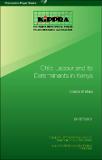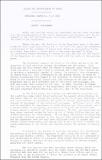| dc.description.abstract | Child labour is a major policy concern in Kenya because it has implications that
persist over a child’s life cycle and across generations. This study examines the
levels of child labour participation across sectors and regions and identifies
some of the main determinants of children’s participation in economic activities.
It uses data from the 2005/06 Kenya Integrated Household Budget Survey
(KIHBS) conducted by Kenya National Bureau of Statistics (KNBS) and used
a national representative sample. Child labour was defined and analysed in
respect of a child’s age, number of hours worked per week, and school attendance.
Child activities were categorized into four main areas, namely schooling only,
working and schooling, working only, and neither schooling nor working. The
characteristics examined in the study were divided into three main categories,
namely child characteristics, household characteristics and community
characteristics. The analysis was based on 23,210 children aged 5 to 17 years. The results show that 7.2 per cent of all children are engaged in child labour, with 39 per cent of
them combining labour and schooling. Children in rural areas and in Rift Valley
and Eastern provinces are more prone to child labour, with the agricultural
sector being the highest employer... | en |




